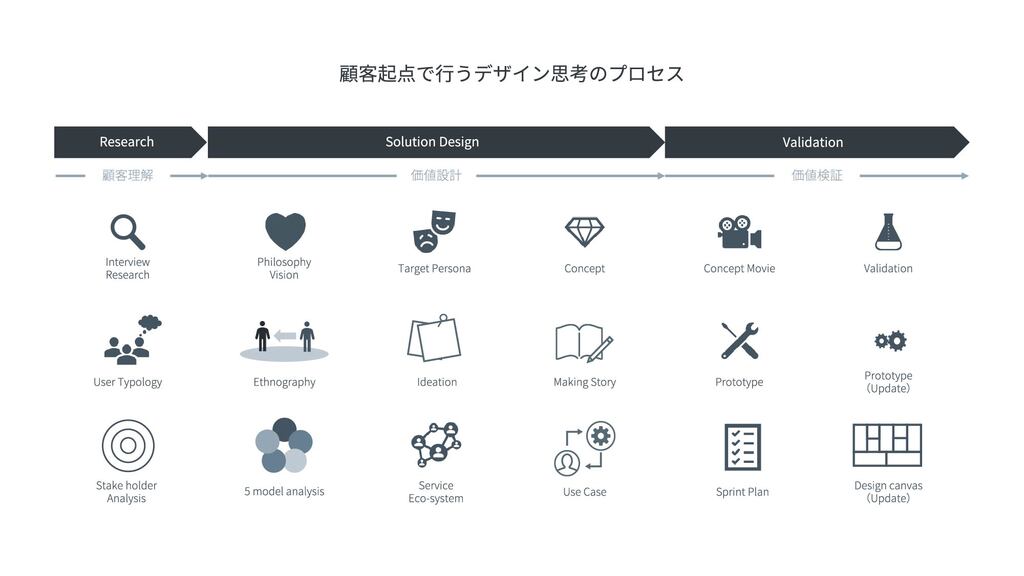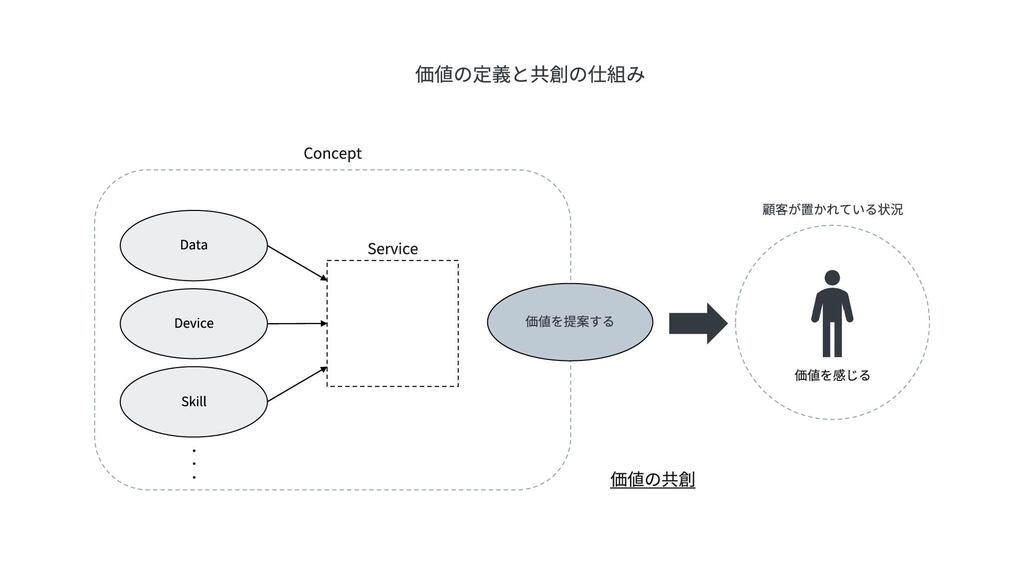Note: This website was automatically translated, so some terms or nuances may not be completely accurate.
Implementing Customer Value with Design Thinking! Key Points for Creating Services Customers Choose
When you hear the term "design thinking," many people probably think of it as an "ideation technique" or a "workshop tool." Indeed, ideation work is part of design thinking, and it often takes the form of workshops. However, the essence of design thinking is neither ideation nor workshops. Here, we will discuss the approach and practice of design thinking, defined as a methodology for designing systems—such as services, apps, products, spaces, and businesses—that fulfill customer desires.
The "Design" Defined by Design Thinking and Its Implementation Process
Design thinking is a methodology that systematizes the sensibilities and thought processes of excellent designers, making them accessible even to non-designers. Before delving into design thinking itself, let's first examine the term "design."
What does "design" mean in this context? Borrowing Steve Jobs' words: "Design is not just what it looks like and feels like. Design is how it works." it works." This definition aligns perfectly with the "design" that design thinking addresses. By applying design thinking, we can integrate various elements—devices, data, skills—to design systems that truly serve people. So, how do we design? Let's explain the design thinking process.

Design thinking involves various workshops, broadly divided into three steps. While each step has a specific order of practice, the process involves repeating multiple cycles to deepen customer understanding and refine ideas.
Step 1: Understand the Customer
Conduct ethnographic research (customer observation) and in-depth interviews to grasp customers' situations and aspirations. If necessary, perform analyses like User Typology—classifying customers based on thought and behavioral characteristics—to gain deeper insights.
Step 2: Create Customer Value
We materialize ideas through activities like Post-it ideation and crafting dirty prototypes using cardboard. Subsequently, we physically grasp the value by performing acting (improvisational theater) using the completed dirty prototypes.
Step 3: Validate Value
This phase involves testing the value of the concretized ideas directly with customers. We proceed step-by-step using methods appropriate for the verification content, ranging from simple testing using concept videos to large-scale field tests. Based on customer reactions, we then decide whether to adjust the direction or proceed with further concretization.
This concludes the design thinking process. Building on this foundation, let's now explore the design thinking approach and its practical implementation.
How does design thinking approach challenges?
Many of you likely hear clients express concerns like, "We don't know how to utilize the data we've acquired..." or "We need to address the issue of customers leaving..." Against a backdrop of heightened focus on data importance and customer diversity, I myself increasingly receive similar consultations.
When such consultations arise, design thinking doesn't jump straight to generating ideas. For example, with a data utilization query, we advance the discussion by considering how data can be used as a means to fulfill customer desires. For a customer attrition concern, we start by examining whether the customers themselves genuinely perceive "losing interest in XX" as a problem.
What both consultations share is that the discussion of the problem is solely from the "company's perspective." Starting only from the company's challenges carries the risk of creating something unnecessary for the customer. Therefore, when such a consultation arises, design thinking takes the approach of reframing the client's challenge from a "customer-centric" viewpoint and then generating ideas. This reframing also makes it easier to judge whether the resulting idea will solve the client's problem while also fulfilling the customer's desires.
Two Commitments Required for Design Thinking Practice
So, what should you pay attention to when actually implementing design thinking in a project? To put it simply, a commitment to "thoroughly understanding the customer" and "co-creating value with the customer" is essential. Hearing these two points, you might think, "Isn't that obvious?" However, the reality is that this obviousness is surprisingly often not achieved. Let's explain what process is needed to commit to these two points.
1. Thoroughly Understanding the Customer
First, let's address "understanding the customer." Needless to say, unless you are the customer yourself, customers are fundamentally different from you. Consequently, their thought processes, behavioral traits, and perceptions of value differ. Understanding these differences and internalizing them is a necessary process for creating value.
Specifically, gather primary data yourself through ethnography (customer observation) and in-depth interviews. Primary data reveals the "real customer" – insights invisible in existing research materials or data. Nothing surpasses the high-resolution customer understanding gained through your own eyes and ears. When undertaking a project, it's tempting to delegate research to project members or research firms. However, research to understand customers must be conducted by the person generating the ideas. Doing so enables handling customer desires with genuine empathy.
2. Co-creating Value with Customers

Next, regarding "co-creating value with customers," let's first explain "value." In service design, "value" is defined not as something inherent to the service itself, but as what customers feel when they engage with the service.
This explanation might sound a bit abstract, so let's illustrate it using the example of a love letter. If the love letter itself held inherent value, receiving one from anyone would bring joy. However, that's not how it works in reality. Receiving one from someone you like brings happiness, while receiving one from someone you don't like might leave you unsure how to respond. The recipient's feelings vary depending on their situation.
The same applies to services. In other words, value means "what the customer feels when encountering the service within their specific circumstances." Therefore, as service creators, we can only propose value; the customer alone can truly understand it.
Based on this premise, creating value requires a process of co-creation with the customer, listening to them. This approach is also the key difference between "communication design"—which includes advertising—and "service design," which designs the customer experience and the business model itself. In communication design, the release is the goal. While customer reactions are observed as a measure of effectiveness, value co-creation does not occur. In service design, however, the release is just the beginning. It requires continuous course correction and updates based on customer feedback to continually validate the value. In other words, to create a service with customer value, a co-creation process—building value together through dialogue with the customer—is indispensable.
We've now examined the two essential elements for creating customer value. Because these require careful, time-intensive execution, many tend to skip the process. However, thoroughly implementing these two points is what leads to creating mechanisms that solve client challenges and fulfill customer desires.
Using design thinking enables next-level BX, CX, and DX
Design thinking has gained attention in the business design field because it systematizes the sensibilities and thought processes of excellent designers, making them accessible even to non-designers. So, what developments can we expect when applying design thinking to the "BX (Business Transformation)", "CX (Customer Experience)", and "DX (Digital Transformation)" that many companies are currently focusing on? Also, how do the required capabilities differ from those needed in communication design? Let's examine each one.
1. Application to BX
Applying design thinking in the BX domain enables the creation of services with high customer value. By the way, did you know that service design and communication design share many similarities? One such similarity is defining the symbolic identity for a service. This definition requires the ability to organize value and shape it into a form that resonates with customers. This is precisely why individuals with a background in communication design can also excel in the service design domain.
On the other hand, service design also has aspects distinct from communication design. To bridge these differences, I recommend adopting the approach of "using design thinking as a supporting framework." Even those with a background in communication design can leverage design thinking as this supporting framework. This allows them to utilize their existing capabilities while creating BX with high customer value.
2. Expansion into CX and DX
The topics explored in CX and DX actually overlap significantly with those addressed by design thinking. In CX, the focus is on enhancing customer experience and supporting customer success. Design thinking similarly treats customer experience as a core theme, aiming to achieve customer success through iterative course correction and updates.
In DX, when considering how to realize ideas, the focus is on leveraging technology and data to deliver customer value. This means exploring technology utilization from a customer perspective, adopting an approach similar to design thinking. Since the considerations in CX and DX overlap significantly with design thinking, using design thinking as a guiding principle, much like with BX, could facilitate expansion into CX and DX.
As seen above, leveraging design thinking enables a consistent approach centered on customer aspirations—from proposing customer value to its realization, communication, and ultimately customer success.
Design thinking is highly effective both as a solution to various challenges and as a method for creating next-generation business models. Many people within the Dentsu Group possess the DNA of wanting to "make the world more interesting." I see design thinking as the tool that applies this DNA to areas beyond communication design, which has been our strength until now. Why not take that first step into new domains like BX, CX, and DX with us?
The information published at this time is as follows.
Was this article helpful?
Newsletter registration is here
We select and publish important news every day
For inquiries about this article
Author

Tomoyuki Oka
Dentsu Inc.
Sustainability Consulting Office
After completing the Graduate School of Media Design at Keio University, he practiced design consulting using design thinking at IBM Japan, Ltd. He has been in his current position since 2019. He works on corporate branding in the sustainability field, supporting new business creation and service design.

